


 |
April 30 - May 14, 1981: Some Classes in Saudi Arabia |
 |
January 26-30, 1981: A Week in New York City |
 |
Return to the Index for 1981 |
In February, an opportunity came up to teach a series of three classes for ARAMCO in Dhahran, Saudi Arabia in early May. I was one of the few instructors who could teach all three of the classes, and so Trish asked me if I would like to go. Although I was a little apprehensive about going to the Middle East, it being an area of the world different from Europe, the Orient, South America or the United States, I thought that I might never again have the opportunity to go, so I took it.
|
I had called the people at ARAMCO to find out a little about what to expect. One thing they told me was that everyone dressed casually and that it would be quite warm. So I went out and stocked up on pullover shirts, and just planned to wear those and slacks or jeans. I got all packed, and on the evening of the 28th of April went out to O'Hare to catch the evening non-stop for Frankfurt.
The shot at left was taken at O'Hare Airport; it is the Lufthansa 747 that I took to Germany on my way to Saudi Arabia.
Writing this narrative from my perspective about two months after I returned, I can say with some assurance that this trip would turn out to be the most important one I have ever taken. While I can't predict the future, I really can't imagine that any trip or event in my life is going to ever surpass the impact and implications of the things I did, and especially the things I learned, on this trip. Odd that I should have to travel halfway around the world, to a place so foreign and different, to discover so much. But more about all that later.
|
Going through Customs was very easy; they have a system in Europe that says if you have nothing to declare, you just walk through a green door right into the main terminal. There are guards stationed there, and you do have to show a visa in some cases, but apparently all European and American travelers can get right in without stopping.
I can only assume that the guards are experienced enough to tell when someone really does have something they should declare. I suspect, too, that German duties on imported goods are small, and that it is not worth the trouble not to declare things you actually do bring in. Steve tells me this "green door/red door" system is prevalent throughout Europe.
|
Frankfurt is located in central West Germany, about halfway between France and the border with East Germany. Since World War II, Frankfurt has become a "world city"- a global hub for commerce, culture, education, tourism and traffic. It's the site of many global and European headquarters, and the Frankfurt Airport is among the world's busiest. Frankfurt is the major financial centre of the European continent; the headquarters of the German Federal Bank, Frankfurt Stock Exchange, Deutsche Bank, and Commerzbank are all located here. Messe Frankfurt is one of the world's largest trade fairs, and the world's largest automobile show and book fair are held here.
Frankfurt is located in what was originally a swampy portion of the Main valley, so the oldest parts are found atop the area's hills. A Roman road passed through the valley, and the mountain ranges surrounding the area gave it a defensive advantage. The oldest part of the Altstadt, the old city center, is on an island called Cathedral Hill, adding to its early military and economic advantages. The first proven settlement and land development date to the Roman era. It is assumed that the Romans settled on the hill in the last quarter of the 1st century AD; amongst other things, a Roman bath has been found. Apparently, Roman military occupation ended during the Second Century, and the area became a farming center. With the retreat of the Roman border to the west bank of the Rhine in 259/260, the Roman history of Frankfurt came to an end.
|
Louis the Pious, Charlemagne's son, selected Frankfurt as his seat, extended the palatinate, built a larger palace, and in 838 had the city encircled by defensive walls and ditches. After the Treaty of Verdun (843), Frankfurt became to all intents and purposes the capital of East Francia. Kings and emperors frequently stayed in Frankfurt, and Imperial Diets and church councils were repeatedly held there. The establishment of religious monasteries and numerous endowments to the local church furthered the urban community. Also, as the Holy Roman Emperor had no permanent residence anymore, Frankfurt remained the center of imperial power and the principal city of Eastern Francia.
Frankfurt's importance declined under the Saxon emperors, but the Crusades changed all that. In the local church in 1147 Bernard of Clairvaux called the Hohenstaufen king Conrad III to the Second Crusade. Before leaving for Jerusalem, Conrad selected his ten-year-old son as heir, but the boy died before his father. The election of emperor Frederick Barbarossa was performed in Frankfurt in 1153, and the city became the customary place for the election of the German kings. By 1180 the city had expanded greatly, and by 1250 had seen an increase in privileges. Citizens selected their own mayors and officials, who were responsible for police management and some judicial duties. These officials enjoyed the increasing favor of the emperors, and the city became more and more autonomous.
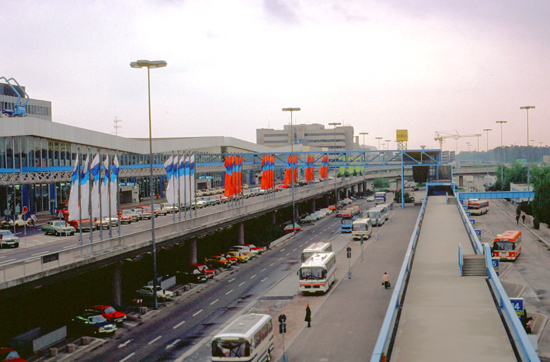 |
I was only going to be here one night here, so Steve put me into a Ramada Hotel right at the airport. I was shocked to find that the room was $100 a night, and for a small room at that. I have always been used to American hotels on the standard of Holiday Inn, and the only time I have paid that much for a room has been in New York City, and even then I didn't quite break $100. I guess Europe is extremely expensive.
Although I was a bit tired, and the day was cool and overcast, I decided to go into the city to see what it looked like. There is, of course, a train that goes right from the airport into the city. Trains in Europe are like trains in Japan- very convenient. So I took a short nap (I don't sleep much on planes), and then hopped on the train for town.
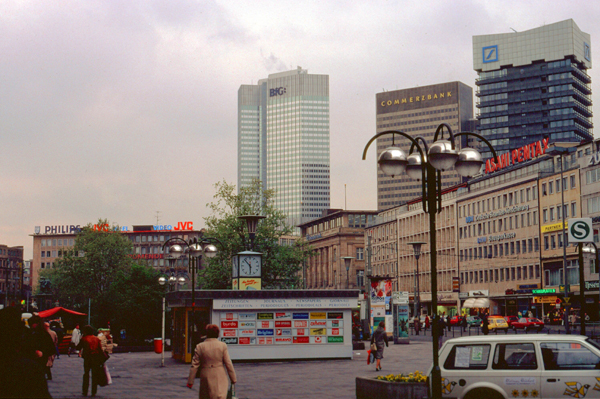 |
As you may already know, I am fond of locating aerial views of the places I have visited, and relating my pictures to those views. I have tried to do that for Frankfurt, but the views I have found have two problems. First, as is true with many satellite views of areas outside North America, the resolution seems to be much less and so the views much less clear. But more important, the passage of time seems to have made the discrepancy between my pictures from 1981 and the aerial views taken 30+ years later. For example, I tried to find the Commerzbank Building on the aerial view, but they apparently have an entirely new headquarters, and so I can't simply match this building to one that I might easily find via a Google search in 2017, as I am creating this page.
Frankfurt's history has led to its dramatic growth. Starting from the 16th century, trade and the arts flowered in Frankfurt. Science and innovation progressed, and the invention of the printing press in nearby Mainz promoted education and knowledge. In the Thirty Years' War, Frankfurt was able to maintain its neutrality; but after that war, Frankfurt, like most places, was ravaged by the plague. In the 1648 Peace of Westphalia, Frankfurt was confirmed as an Imperial Free City, and soon reached new heights of prosperity. The Palais Barckhaus at Zeil in Frankfurt even served as residence of Emperor Charles VII until 1744.
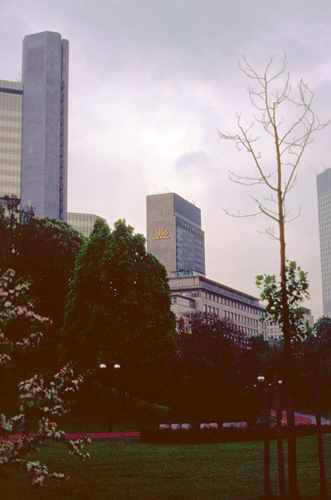 |
|
Frankfurt was briefly occupied in 1792 by the French during their Revolutionary War, and again in 1806. Frankfurt's status as a free city ended when it was reorganized into the Grand Duchy of Frankfurt. Centuries-old defensive walls were dismantled, replaced by garden plots. In 1813, however, Frankfurt's old rights were reestablished, and the Congress of Vienna confirmed that Frankfurt was a Free City of the German federation, and in 1816 it became the seat of the Bundestag. By 1848, Frankfurt was the center of all political life in Germany. The next fifteen years saw new industrial laws focusing on complete freedom of trade, and political Emancipation of the Jews, initiated ten years before its final realization in 1864. As a result of the Austro-Prussian War in 1866, Frankfurt was annexed by Prussia, but its development continued unabated.
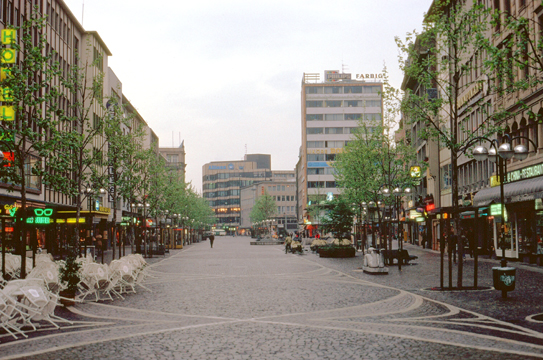 A Typical Shopping Street in Frankfurt The weather was not good and it was getting late; all the chairs for the outdoor restaurants have been gathered up. |
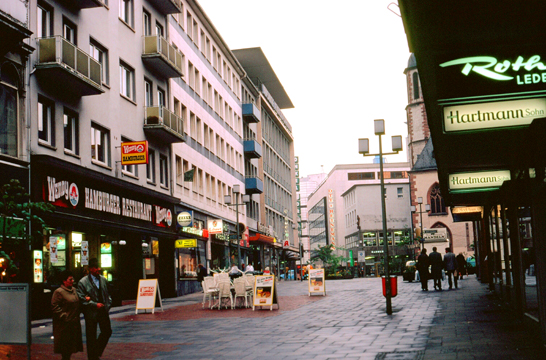 A Reminder of Home Just as I was getting used to the foreign nature of the city, and just as I was wondering what I could eat for dinner, I turned the corner and found this reminder of home. |
I guess I shouldn't have been surprised; after all, I've seen McDonalds from Hong Kong to Paris, and I've seen Baskin-Robbins in Paris and London. I'm not very adventurous when on my own, so I had something to eat here. Although everything was in German, I could tell from the position on the menu board, and the relative prices in marks what everything was, and I placed my order with the best German accent I could muster.
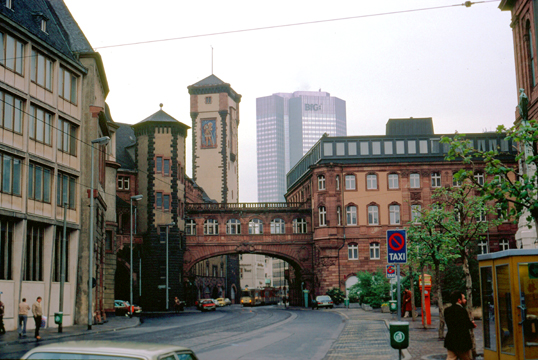 In the Older Section of Frankfurt After having something to eat, I continued to wander around, and came into this older section of the city. The older section is called "Altstadt," and the newer section, where most of the previous shots were taken, is called "Neustadt." These are some municipal buildings. |
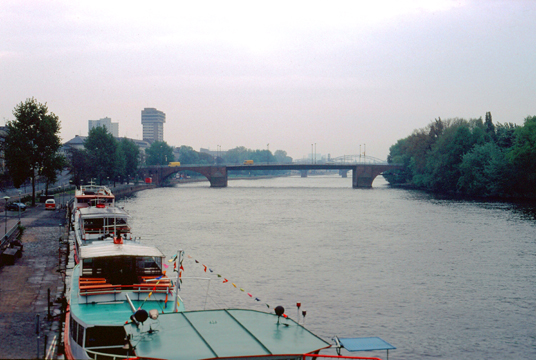 The Main River The city of Frankfurt is also called Frankfurt-am-Main, which means "Frankfurt on the Main," since the city is located on both banks of the Main River. There are apparently excursion boats on the river, but the weather was not such today that they were busy. |
Large parts of the city center were destroyed by in the bombings of the second World War- including the entire Old City. Allied forces reached the city in late March 1945; the city was finally liberated on 4 April 1945. Frankfurt became the center for the post-war military government. Reconstruction began immediately, and in 1946 Frankfurt joined the state of Hesse. The city vied with Bonn to become the West German federal capital, but the vote narrowly favored Bonn. But Frankfurt saw opportunity in the relative isolation of Berlin to take over a preeminent position in trade and commerce. Frankfurt, Hamburg, and Munich realigned themselves, passing from regional centers to international metropolises and effectively forming three West German cultural and financial capitals. The Deutsche Bundesbank made Frankfurt its seat, and most major banks followed suit. This and the Frankfurt Stock Exchange have made the city the second most important commercial center in Europe, after London.
|
|
A new Church was built on the same site by Cathedral Master Architect and Builder Denzinger. In 1881, the Church was dedicated “The Three Kings”. The Three Kings Church joined the “Bekennende Kirche” (Confessional Church) in 1934, a movement which opposed Nazi ideology. Between October 1943 and March 1944, the old town of Frankfurt, the largest old Gothic town in Central Europe was destroyed by six bombardments of the Allied Forces. The Three Kings Church suffered severe damage and the interior was burned out completely. The present church is the result of a reconstruction effort in the 1950s, and the church today is essentially unchanged from that reconstructed building. The tallest church spire (at just under 300 feet) in Frankfurt is here.
|
As I work on this page in 2017, I am struck particularly by my reference to sailing here, and the fact that I would meet someone who had such a passion for it. I certainly did learn how much room it takes to turn a sailboat; while it can be done on a river or in a short space, if the wind is not blowing in the right direction, a session of sailing on the Main would be just one tack after another.
I wish the weather had been more cooperative. The city did not look as nice as it must be in this overcast, cool weather. I can just imagine what it must look like on a clear Spring or Fall day; I wish I had been here during that time. Now, the excursion boats are all tied up, and few people were outside.
When my light faded, I found a local train station and returned to the main station in order to catch a train back out to the airport and my hotel. In the main station, I found numerous "German fast food" restaurants and tried one of them. Very good. I was back at the Ramada by about nine o'clock in the evening.
|
|
I was not taking this picture just to record my flight data, but because these announcement boards struck me with the feeling that I was indeed at a crossroads of the world. Certainly I have been in busy airports in my time, but there is something different between being in an airport where flights to New York, Chicago, Atlanta and San Francisco (with the occasional flight to Honolulu or Paris) are listed, than to be in an airport like this one where almost every destination is a fabled location one has heard about. From this airport, at this time of the day, for example, you can go to Oslo, Bonn, Ankara, New York City, Barcelona, Stuttgardt, Moscow, Helsinki, Saarbrucken, Munich, Dubai, Dhahran, San Francisco, Los Angeles, Lagos, Abu Dhabi, Kuwait, Miami, Berlin, London, Budapest, Rhodes, Milan, Pisa, Djakarta, Singapore, Lisbon, Copenhagen, Tel Aviv, Las Palmas, Valencia, Amsterdam and Hamburg. Had there been a flight listed to Sydney, then all six inhabited continents would have been represented. I know that distances in Europe and in this part of the world are shorter, and perhaps this list isn't so different from a departure board in Chicago that lists cities on both coasts, in Texas and in Florida. But it certainly seems different!
You can use the links below to continue to another photo album page.
 |
April 30 - May 14, 1981: Some Classes in Saudi Arabia |
 |
January 26-30, 1981: A Week in New York City |
 |
Return to the Index for 1981 |